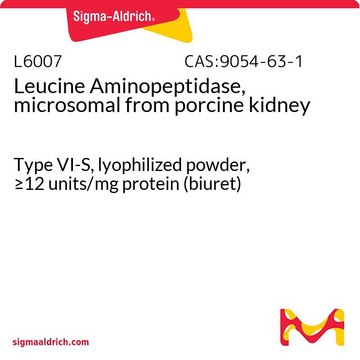A8200
Aminopeptidase from Aeromonas proteolytica
lyophilized powder, 50-150 units/mg protein
Synonym(s):
AAP, Aminopeptidase from Vibrio proteolyticus, bacterial leucyl aminopeptidase
About This Item
Recommended Products
grade
Proteomics Grade
Quality Level
form
lyophilized powder
specific activity
50-150 units/mg protein
mol wt
29.5 kDa
composition
Protein, ~40% biuret
solubility
H2O: soluble 0.9-1.1 mg/mL, clear, colorless
foreign activity
endopeptidase, essentially free
storage temp.
−20°C
General description
Specificity
Application
Biochem/physiol Actions
Unit Definition
Physical form
Preparation Note
Signal Word
Danger
Hazard Statements
Precautionary Statements
Hazard Classifications
Eye Irrit. 2 - Resp. Sens. 1 - Skin Irrit. 2 - STOT SE 3
Target Organs
Respiratory system
Storage Class Code
11 - Combustible Solids
WGK
WGK 1
Flash Point(F)
Not applicable
Flash Point(C)
Not applicable
Personal Protective Equipment
Certificates of Analysis (COA)
Search for Certificates of Analysis (COA) by entering the products Lot/Batch Number. Lot and Batch Numbers can be found on a product’s label following the words ‘Lot’ or ‘Batch’.
Already Own This Product?
Find documentation for the products that you have recently purchased in the Document Library.
Customers Also Viewed
Our team of scientists has experience in all areas of research including Life Science, Material Science, Chemical Synthesis, Chromatography, Analytical and many others.
Contact Technical Service


